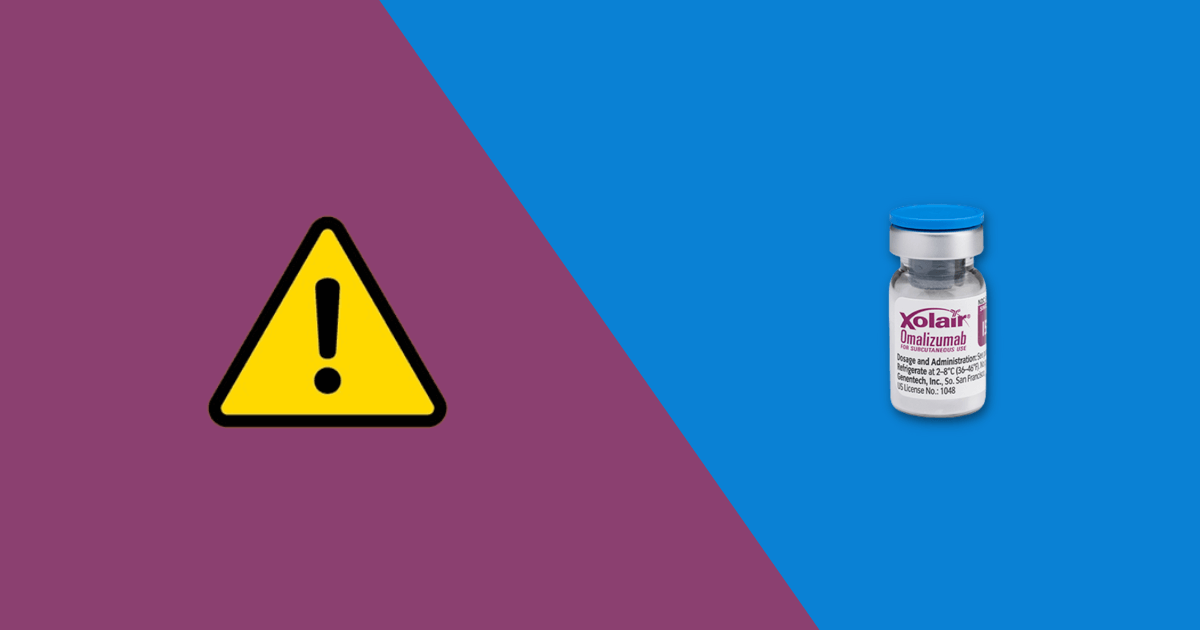Xolair side effects and how to avoid them
Table of contents
Xolair is a brand-name medication manufactured by Genentech, Inc. It is classified as an anti-immunoglobulin E (IgE) antibody and is used to treat asthma symptoms, nasal polyps, and chronic hives. While Xolair is generally well tolerated, there are some potential side effects that people should be aware of. The most common side effects of Xolair include injection site reactions and infections. Less common, but more serious side effects, can include blood clots.
Learn more about the side effects of Xolair and what you can do to avoid them.
What is Xolair (omalizumab)?
Xolair (omalizumab) is an injectable biologic medication. It was approved in 2003 by the U.S. Food and Drug Administration (FDA) to treat asthma symptoms, nasal polyps, and chronic hives. Your first dose of Xolair is typically given in a healthcare setting such as your doctor’s office due to the risk of severe allergic reactions.
Xolair is an anti-immunoglobulin E (IgE) antibody. IgE plays an essential role in your immune system’s response to allergens. Xolair binds to IgE receptors in mast cells, preventing them from releasing histamine and other chemicals that are associated with your body’s allergic response as well as inflammation. Xolair can reduce the IgE levels in your blood by more than 90%, which helps reduce the symptoms of asthma and other conditions.
More information on what is Xolair and Xolair dosage
What does Xolair do?
Xolair (omalizumab) is an anti-IgE antibody indicated to treat:
- Moderate to severe persistent asthma in patients 6 years of age and older for whom other asthma medications such as inhaled corticosteroids have not worked
- Nasal polyps in adults who did not respond to nasal corticosteroids
- Chronic spontaneous urticaria (CSU), which used to be called chronic idiopathic urticaria (CIU), in patients 12 years of age and older who still have symptoms after taking antihistamines
Xolair should not be used to treat acute asthma attacks, bronchospasm, or other allergic conditions besides CSU.
What are the most common side effects of Xolair?
The most common side effects of Xolair include:
- Joint pain
- Injection site reactions
- Leg pain
- Dizziness, headaches, tiredness
- Sinus infections, sore throat, common cold symptoms
- Fever
- Nausea
- Earache
- Rash
- Upper abdominal pain
- Upper respiratory tract infections
- Nose bleeds
Xolair can cause more serious side effects, including:
- Life-threatening allergic reactions (hives, chest tightness, low blood pressure, shortness of breath, and trouble breathing
- Increased risk of heart attack, blood clots, and chest pain
- Increased risk of cancer
- Bone fractures
- Inflammation of the blood vessels
- High risk of parasitic infections
If you experience any of these serious side effects, stop taking Xolair and seek medical attention immediately. You are encouraged to report negative side effects of prescription drugs to the FDA. Visit www.fda.gov/medwatch, or call 1-800-FDA-1088.
What are Xolair’s long-term side effects?
Long-term side effects of Xolair may include an increased risk of cancer, osteoporosis, inflammation of blood vessels, and increased risk of heart attack, blood clots, and chest pain.
How long do Xolair side effects last?
Some side effects of Xolair may occur shortly after Xolair injection or within five days. How long the side effect last will depend on the side effect. Speak to your healthcare provider about any side effects you experience, especially those that are persistent.
Xolair dosage
Xolair is available in injection form in the following doses: 75 mg/0.5 mL and 150 mg/mL in a single-dose prefilled syringe, or 150 mg lyophilized powder in a single-dose vial.
You are advised to read the prescribing information and medication guide provided with this medicine for the full drug information and patient information, and always speak with your healthcare provider for medical advice about any changes to your dose so they can monitor and evaluate your condition.
Xolair drug interactions
When Xolair is taken with other medications, it may change the way they work or increase the frequency and severity of side effects. No formal drug interaction studies have been performed with Xolair. However, you should discuss with your doctor whether any of the prescription drugs, over-the-counter medications, vitamins, and herbal supplements you take may interact with this medication.
Xolair warnings & precautions
Don’t take Xolair if you:
- Are allergic to the active ingredient omalizumab
- Are allergic to any of the other ingredients in Xolair (you can find these listed in the leaflet which comes with the medication)
- Are allergic to latex (the needle cap of the syringe may contain latex)
- Are under six years of age for the treatment of allergic asthma
- Are under 12 years of age for the treatment of hives (chronic spontaneous urticaria)
- Are using it to treat allergic conditions other than allergic asthma or hives (chronic spontaneous urticaria)
Talk to your doctor before taking Xolair if you:
- Have a kidney or liver condition
- Have an autoimmune disease
- Have ever had a severe allergic reaction (anaphylaxis) brought on by other medication or by non-medical causes, like an insect bite or by food
- Are pregnant or trying to become pregnant
- Are breastfeeding or are planning to breastfeed – It is not known if Xolair passes into breast milk
You should always check with your doctor or pharmacist before taking any medication, including Xolair, to make sure it is safe for you.
How effective is Xolair?
Xolair’s effectiveness is dose-dependent. Those using Xolair 300 mg had around 66% reduction in the severity of their itching and hives. Those using Xolair 150 mg saw almost a 50% reduction in the same symptoms.
How dangerous is Xolair?
Xolair may cause serious side effects such as breast cancer, prostate cancer, bone fracture, and parasitic infection.
Does Xolair cause hair loss?
Xolair may cause hair loss in around 2% of patients. Hair loss will last for a short period of about 3 to 4 months.
Does Xolair cause hives?
Xolair treatment may cause an allergic reaction, including anaphylaxis, symptoms of which may include a skin rash.
Does Xolair weaken your immune system?
Xolair does not weaken the immune system and is not linked to an increased risk of infection.
How long can you stay on Xolair?
Xolair treatment is recommended for 4 weeks for conditions such as chronic hives but most patients can tolerate longer treatments and will use Xolair as a long-term treatment.
Can Xolair cause weight gain?
Xolair does not cause weight gain or weight loss. Speak to your doctor if you have changes in your weight while taking Xolair.
What cancers are associated with Xolair?
Cancers most commonly associated with Xolair treatment include breast, prostate, melanoma, non-melanoma skin, and parotid cancer.
Can Xolair be used in children?
Xolair may be used in children 6 years of age and older, already being treated with high-dose steroid and beta-agonist inhalers whose symptoms are not well controlled.
What is the cost of Xolair?
Xolair prices will vary depending on where you buy it from and if you purchase the pre-filled syringes or the powder for subcutaneous injection. As a guide, you can expect to pay over $1,000 for a 150 mg pack of powder for injection.
Can Xolair cause heart problems?
Patients have experienced chest pain, heart attack, blood clots in the lungs, weakness on one side of the body, changes in vision, and slurred speech when using Xolair.
Can Xolair cause a risk of a heart attack?
Xolair may increase the risk of heart attack, blood clots, and chest pain.
How to avoid Xolair side effects
The best way to avoid side effects is to take Xolair as directed by your doctor. Follow your doctor’s instructions carefully and do not take more or less than prescribed.
If you experience any side effects, talk to your doctor or pharmacist. They may be able to recommend ways to help reduce or prevent some of the side effects.
1. Stick to the recommended dosage
Take your prescribed dose of Xolair that has been recommended by your healthcare professional. Do not take more or less than prescribed.
2. Monitor your blood sugar levels
If you have diabetes, it is important to monitor your blood sugar levels closely while taking Xolair. Check your blood sugar levels as directed by your doctor and report any changes to your doctor immediately.
3. Drink plenty of fluids
Drink eight to 10 glasses of water or fluids every day to help prevent dehydration, which can make side effects worse.
4. Avoid alcohol
Moderate alcohol consumption is safe when treated with Xolair, but alcohol may increase your risk of side effects such as headaches or nausea.
5. Don’t skip meals
Eating regular meals and snacks will help to prevent low blood sugar levels (hypoglycemia).
6. Check your feet
If you have diabetes, check your feet for any cuts, sores, or redness regularly. Tell your doctor if you experience any problems with your feet while taking Xolair.
7. Know the signs and symptoms of Xolair side effects
Signs and symptoms of side effects of Xolair include upper respiratory infections. If you experience any of these symptoms speak to your doctor for medical advice.
8. Tell your doctor about all medications you’re taking
Be sure to tell your doctor about all other medications you’re taking, including over-the-counter drugs, vitamins, and herbal supplements, as they can interact with Xolair.
9. Get regular medical check ups
It is important to get regular medical check ups and monitor your medical conditions. Your doctor will monitor your side effects and may adjust your dose of Xolair as needed.
Medically reviewed
A medical professional has reviewed this article.


Jamie Winn, PharmD
Jamie Winn, PharmD
Dr. Jamie Winn received his Doctor of Pharmacy in 2002 from the University of South Carolina College of Pharmacy, Columbia, SC. Jamie is a medical reviewer for NiceRx.

